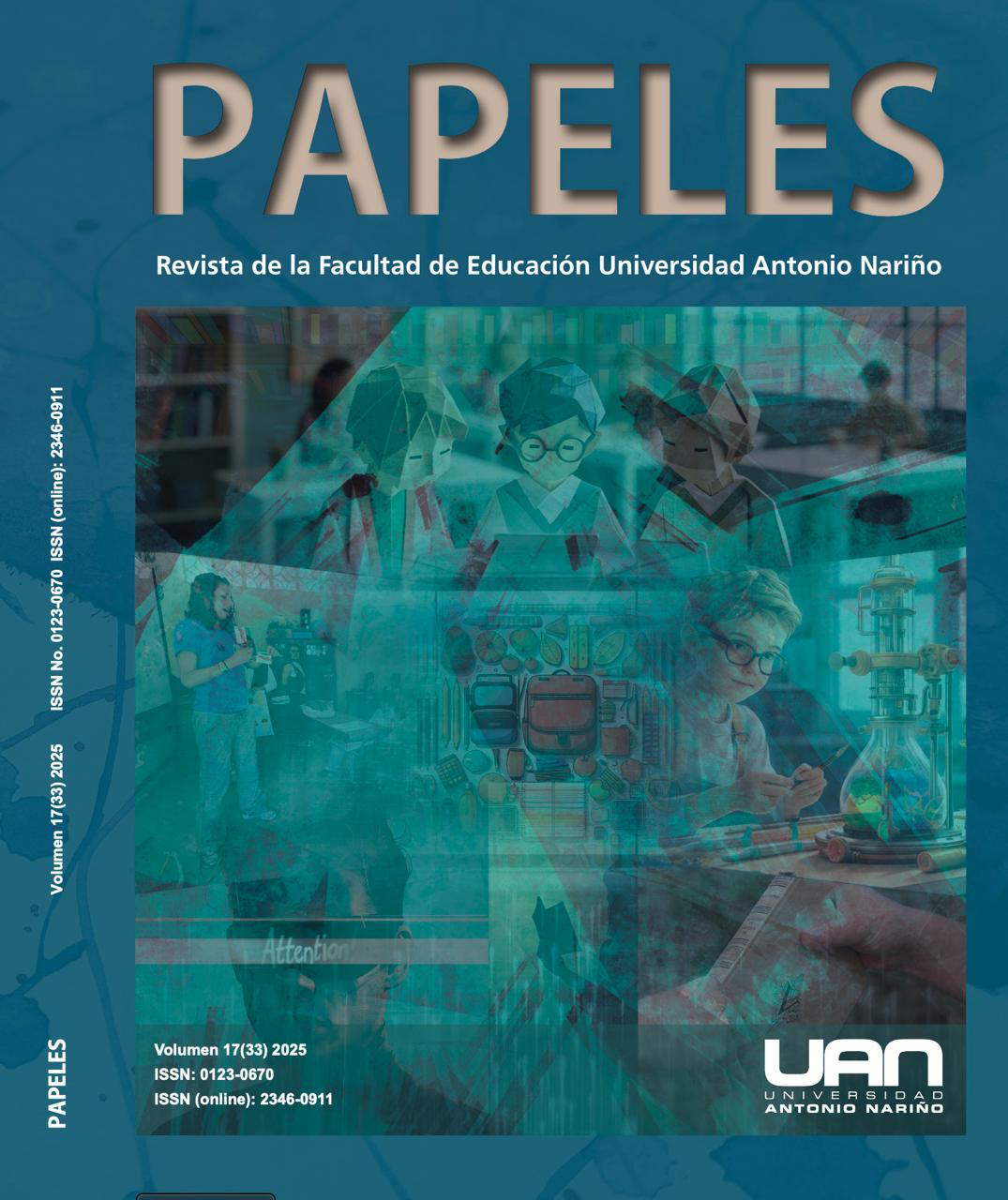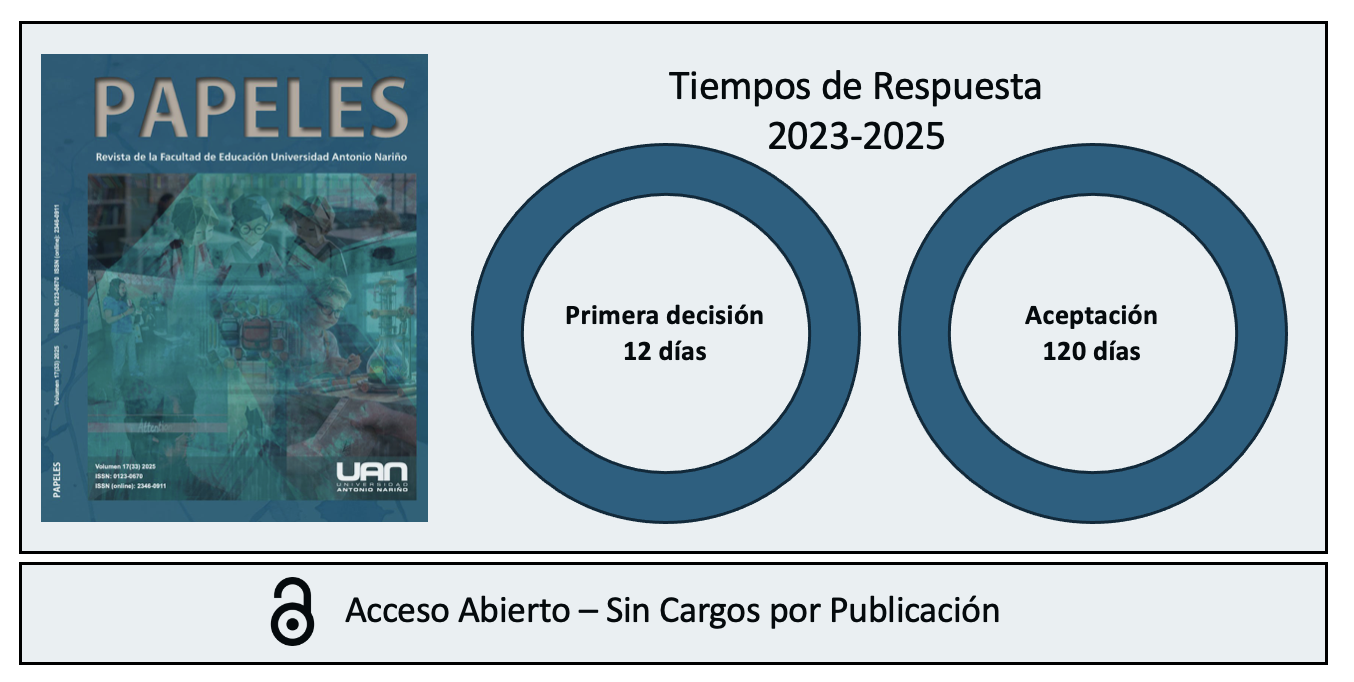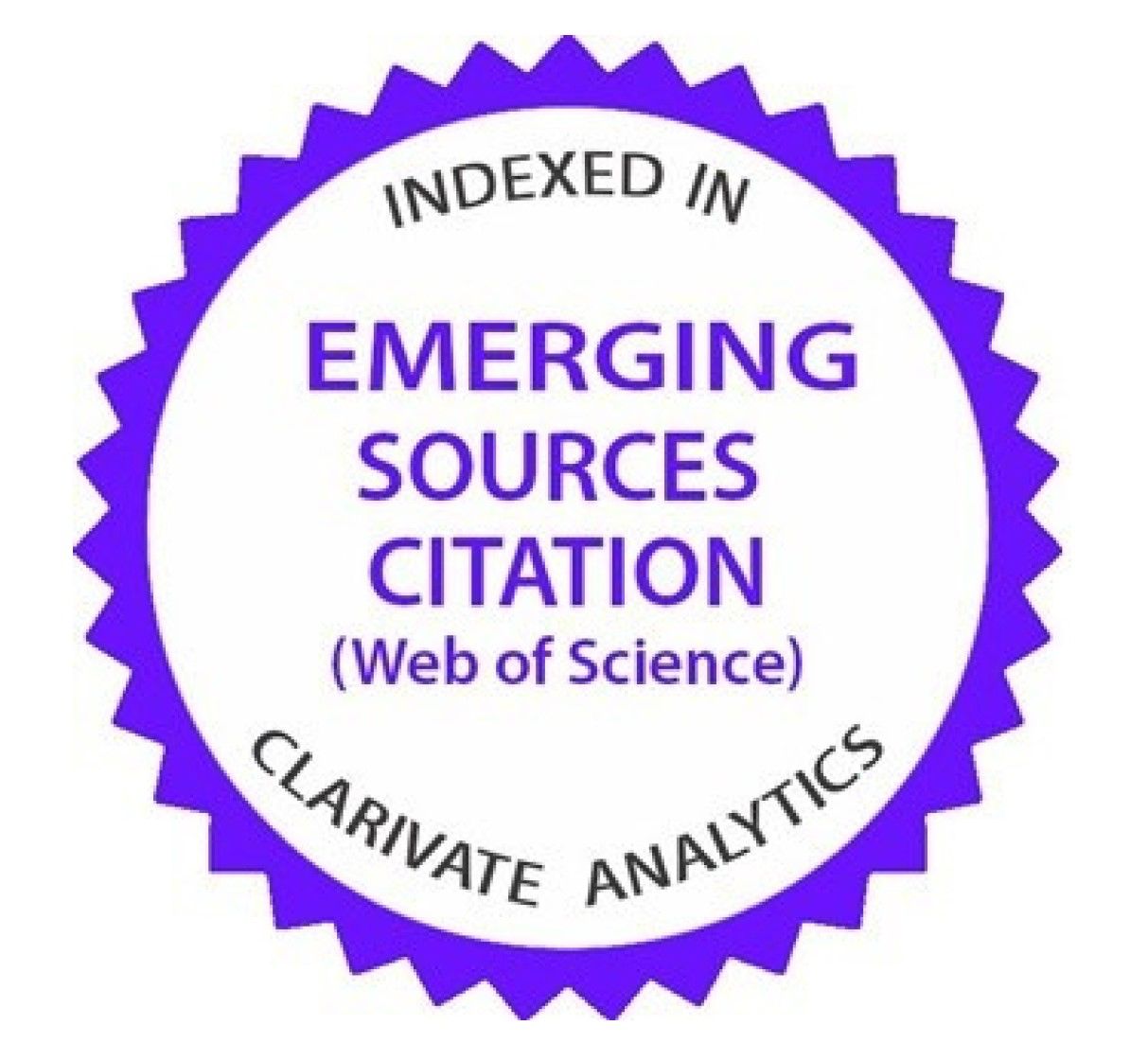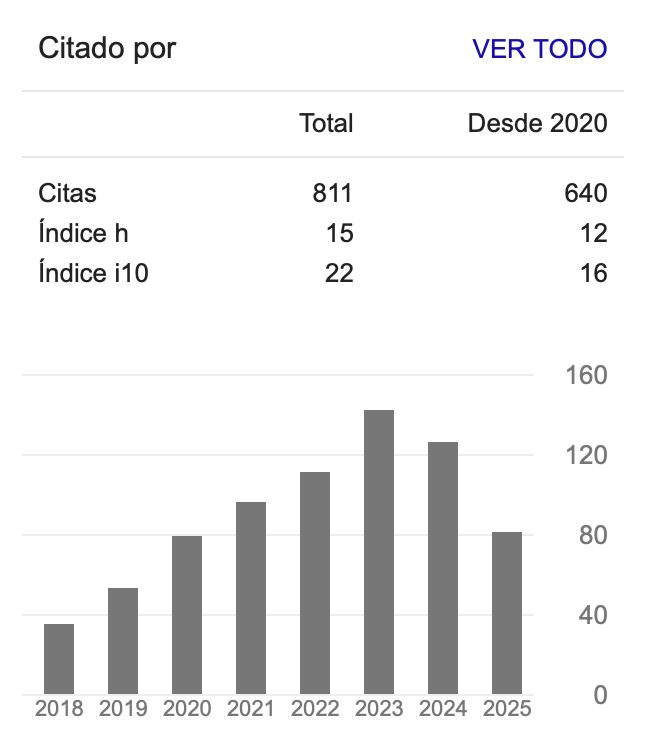Estrategia de andamiaje y desarrollo de la expresión oral en el proceso de enseñanza del inglés
Scaffolding strategy and speaking skills development in the English teaching process
DOI:
https://doi.org/10.54104/papeles.v17n33.2067Palabras clave:
Andamiaje, Habilidades orales, Adquisición del idioma inglésResumen
Introducción: el propósito de este artículo de revisión es proveer a los lectores una visión general de las investigaciones sobre la influencia de la estrategia del andamiaje en el desarrollo de las habilidades orales en inglés, incluyendo información, como su efectividad en el aula de clases de inglés y un recuento de los aspectos de la estrategia que deberían ser desarrollados. Metodología: a través de la exploración de dos bases de datos: ERIC (Education Resources Information Center) y Scilit (Scientific & Scholarly Research Database), los autores recolectaron trece artículos publicados entre 2020 y 2024. La revisión se enfoca en analizar la efectividad de la aplicación del andamiaje para el mejoramiento de habilidades orales en inglés, con énfasis en los tipos de andamiaje empleados y sus características. Resultados y discusión: el análisis de los artículos se basa en cuatro tipos de andamiaje principales: conceptual, procesal, estratégico y metacognitivo. El andamiaje conceptual introduce a los alumnos a piezas clave de información; el andamiaje procesal se refiere a la asistencia dada en relación con la utilización de herramientas para el aprendizaje; el andamiaje estratégico se relaciona con el uso de procedimientos alternativos para alcanzar un objetivo, y, finalmente, el andamiaje metacognitivo fomenta la autorregulación y reflexión, así como se apoya en la retroalimentación. Los estudios seleccionados han sido etiquetados de acuerdo con esta clasificación, y así obtener artículos que incluyen de uno a múltiples tipos de andamiajes. Conclusión: este artículo demuestra que el andamiaje es una estrategia altamente efectiva para desarrollar las habilidades orales de los estudiantes de inglés.
Descargas
Citas
Abedi, N. (2022). The impact of technology-mediated scaffolding on the development of EFL learners’ speaking components. El Guiniguada, 31, 54-68. https://doi.org/10.20420/elguiniguada.2022.505
Almeida Obando, M. E., Bastidas Guevara, N. C., Mantilla Carrera, P. N., Solís Mejía, J. G., & Bejarano Urquizo, L. E. (2024). Scaffolding techniques and speaking skill. Arandu UTIC, 11(2), 206-225. https://doi.org/10.69639/arandu.v11i2.258
Arlinda, H. (2020). Teachers’ strategies in providing scaffolding in english for young learners classroom. En Twelfth Conference on Applied Linguistics (CONAPLIN 2019) (pp. 84-88). Atlantis Press. https://doi.org/10.2991/assehr.k.200406.017
Azir, I. D. A. (2019). Applying peer scaffolding to enhance the EFL vocational students’ speaking skills. Ethical Lingua: Journal of Language Teaching and Literature, 6(2), 149-157. https://doi.org/10.30605/25409190.v6.149-157
Bahrani, T., & Soltani, R. (2011). Improving the components of speaking proficiency. Canadian Social Science, 7(3), 78-82. https://doi.org/10.3968/j.css.1923669720110703.012
Bao, T. L. Q., & Hung, L. N. Q. (2022). The impact of scaffolding strategies on speaking performance: efl teachers’ perceptions and practices. International Journal of Science and Management Studies (IJSMS), 5(4), 157-166. https://doi.org/10.51386/25815946/ijsms-v5i4p118
Baker, J., & Westrup, H. (2003). Essential speaking skills: A handbook for english language teachers. Continuum International Publishing.
Bertelson, P., Eelen, P., & d’Ydewalle, G. (1994). International perspectives on psychological science (vol. 1). Psychology Press.
Birjandi, P., & Jazebi, S. (2014). A comparative analysis of teachers’ scaffolding practices. International Journal of Language and Linguistics, 2(3), 154-164. https://doi.org/10.11648/j.ijll.20140203.14
Brown, H. D. (1994). Teaching by principles: An interactive approach to language pedagogy etext. Prentice Hall Regents.
Burns, A., & Joyce, H. (1997). Focus on speaking. National Centre for English Language Teaching and Research.
Chambers, F. (1997). What do we mean by fluency? System, 25(4), 535-544. https://doi.org/10.1016/s0346-251x(97)00046-8
Chaney, A. L., & Burk, T. L. (1998). Teaching oral communication in grades K-8. Allyn And Bacon.
Dwigustini, R., Ramadhan, A., Susilawati, S., Halim, N., & Morrison, C. B. (2022). How to scaffold young learners’ english speaking class? Linguistic, English Education and Art (LEEA) Journal, 5(2), 194-206. https://doi.org/10.31539/leea.v5i2.3742
Evenddy, S. S., Gailea, N., & Syafrizal, S. (2024). Exploring scaffolding approach to teach english in higher education. Jurnal Visi Ilmu Pendidikan, 16(1), 215-226. https://doi.org/10.26418/jvip.v16i1.73541
Gibbons, P. (2002). Scaffolding language, scaffolding learning: Teaching english language learners in the mainstream classroom (2.ª ed.). Heinemann.
Goh, C. C. M. (2017). Research into practice: Scaffolding learning processes to improve speaking performance. Language Teaching, 50(2), 247-260. https://doi.org/10.1017/S0261444816000483
Hameed, D. T., & Ateha, H. M. (2020). The effectiveness of using visual scaffolding strategy in teaching english speaking skill to intermediate school students. Journal of Tikrit University for Humanities, 27(10), 14-33. https://doi.org/10.25130/jtuh.27.10.2020.24
Hannafin, M., Land, S., & Oliver, K. (1999). Open learning environments: Foundations, methods, and models. En Charles M. Reigeluth (ed.), Instructional-design theories and models: A new paradigm of instructional theory (vol. 2, pp. 115-140). Routledge. https://doi.org/10.4324/9781410603784
Huang, A. C. (2006). An investigation of communication strategy use in intercultural videoconferencing: A case study of Tamkang University English majors [tesis de maestría, Tamkang University].
Homayouni, M. (2022). Peer assessment in group-oriented classroom contexts: On the effectiveness of peer assessment coupled with scaffolding and group work on speaking skills and vocabulary learning. Language Testing in Asia, 12(1). https://doi.org/10.1186/s40468-022-00211-3
Hopärtean, A. M. (2015). Speak without fear: Using debate as a teaching strategy to minimise adult students’ anxiety in the language classroom. Journal of Linguistic and Intercultural Education, 9(3), 59-70. https://doi.org/10.29302/jolie.2016.9.3.4
Irmawati, D. K. (2016). What makes high-achiever students hard to improve their speaking skill? Journal of English Educators Society, 1(2), 71-82. https://doi.org/10.21070/jees.v1i2.442
Katemba, C. V., & Grace, R. M. (2023). Role-playing improves speaking proficiency skills. Acuity: Journal of English Language Pedagogy, Literature and Culture, 8(2), 244-268. https://doi.org/10.35974/acuity.v8i2.3153
Li, C., & Zhang, L. J. (2023). The development of accuracy and fluency in second language (L2) speaking related to self-efficacy through online scaffolding: A Latent growth curve modeling analysis. Journal of Psycholinguistic Research, 52(5), 1371-1395. https://doi.org/10.1007/s10936-023-09950-7
Megawati, F., & Mandarani, V. (2016). Speaking problems in english communication. En The First ELTIC (pp. 32-37). Universitas Muhammadiyah Purworejo. http://eprints.umsida.ac.id/5355/
Melero, J., Hernández, D., & Blat, J. (2012). A review of constructivist learning methods with supporting tooling in ICT higher education: Defining different types of scaffolding. Journal of Universal Computer Science, 18(16), 2334-2360. https://doi.org/10.3217/jucs-018-16-2334
Meyer, D. K., & Turner, J. C. (2007). Scaffolding emotions in classrooms. En Paul A. Schutz y Reinhard Pekrun (eds.), Emotion in education (vol. 1, pp. 243-258). Academic Press. https://doi.org/10.1016/B978-012372545-5/50015-0
Mirahmadi, H. S., & Alavi, S. M. (2016). The role of traditional and virtual scaffolding in developing speaking ability of iranian EFL learners. International Journal of English Linguistics, 6(2), 43-56. https://doi.org/10.5539/ijel.v6n2p43
Monteira, S. F., Jiménez-Aleixandre, M. P., & Siry, C. (2020). Scaffolding children’s production of representations along the three years of ECE: A longitudinal study. Research in Science Education, 52, 127-158. https://doi.org/10.1007/s11165-020-09931-z
Naibaho, L. (2019). The effectiveness of scaffolding method on students’ speaking achievement. International Journal of Research-Granthaalayah, 7(5), 193-201. https://doi.org/10.5281/zenodo.3238391
Nasiri, A., & Gilakjani, A. P. (2016). A review of efl learners’ speaking skill and the strategies for improvement. Modern Journal of Language Teaching Methods, 6(53), 56-63. https://doi.org/10.26655/mjltm.2016.12.1
Nhi, N. T. U., & Alsaqqaf, A. (2023). Impact of a DMGA scaffolding-based module on improving the EFL speaking skills among vietnamese ESP learners. Arab World English Journal (AWEJ), 14(4), 342-357. https://doi.org/10.24093/awej/vol14no4.21
Page, M. J., McKenzie, J. E., Bossuyt, P. M., Boutron, I., Hoffmann, T. C., Mulrow, C. D., Shamseer, L., Tetzlaff, J. M., Akl, E. A., Brennan, S. E., Chou, R., Glanville, J., Grimshaw, J. M., Hróbjartsson, A., Lalu, M. M., Li, T., Loder, E. W., Mayo-Wilson, E., McDonald, S., & McGuinness, L. A. (2021). The PRISMA 2020 statement: An updated guideline for reporting systematic reviews. British Medical Journal, 372(71), 103-112. https://doi.org/10.1136/bmj.n71
Pishadast, A. (2022). Developing the speaking ability of EFL learners through scaffolding. Journal of Contemporary Language Research, 1(2), 60-64. https://doi.org/10.58803/jclr.v1i2.8
Rajendran, T., & Yunus, M. M. (2021). A systematic literature review on the use of mobile-assisted language Learning (MALL) for enhancing speaking skills among ESL and EFL learners. International Journal of Academic Research in Progressive Education and Development, 10(1), 586-609. https://doi.org/10.6007/ijarped/v10-i1/8939
Reingold, R., Rimor, R., & Kalay, A. (2008). Instructor’s scaffolding in support of student’s metacognition through a teacher education online course: A case study. Journal of Interactive Online Learning, 7(2), 139-151.
Riera, I. M., & Paredes, L. A. (2023). Scaffolding strategy for encouraging speaking skills among tenth graders. Ciencia Digital, 7(3), 6-24. https://doi.org/10.33262/cienciadigital.v7i3.2584
Sabnani, R. L. (2024). Strategy instruction and enhancement of young learners’ speaking skills. Language Teaching Research Quarterly, 41, 67-80. https://doi.org/10.32038/ltrq.2024.41.06
Sah, P. K. (2022). Teacher preparation for primary English education in Nepal: Missing agendas of diversity and inclusion. English Teaching & Learning, 46(4), 373-393. https://doi.org/10.1007/s42321-021-00100-7
Saienko, N., & Nazarenko, I. (2021). Using speaking frames as scaffolding tools to teach university students to speak in ESP. International Journal of Learning, Teaching and Educational Research, 20(4), 99-115. https://doi.org/10.26803/ijlter.20.4.6
Sari, D. K., & Rozimela, Y. (2021). The implementation of scaffolding strategies at speaking English course in Kampung Inggris Pare East Java. En Ninth International Conference on Language and Arts (ICLA 2020) (pp. 51-56). Atlantis Press. https://doi.org/10.2991/assehr.k.210325.010
Sarmiento-Campos, N. V., Lázaro-Guillermo, J. C., Silvera-Alarcón, E. N., Cuéllar-Quispe, S., Huamán-Romaní, Y. L., Apaza, O. A., & Sorkheh, A. (2022). A look at Vygotsky’s sociocultural theory (SCT): The effectiveness of scaffolding method on EFL learners’ speaking achievement. Education Research International, 2022(1), 3514892. https://doi.org/10.1155/2022/3514892
Shahidzade, F., Fazilatfar, A. M., & Razmi, M. H. (2022). The correspondence between students’ and teachers’ views on teachers’ emotional scaffolding strategies in english classes in Iran. Frontiers in Psychology, 13. https://doi.org/10.3389/fpsyg.2022.874747
Shahini, G., & Shahamirian, F. (2017). Improving english speaking fluency: The role of six factors. Advances in Language and Literary Studies, 8(6), 100-104. https://journals.aiac.org.au/index.php/alls/article/view/4012/3197
Sim, S. P. L., Sim, H. P. K., & Quah, C. S. (2023). Impact of online instructor scaffolding strategies on students’speaking performance. Malaysian Journal of Sustainable Environment, 10, 105-126. https://doi.org/10.24191/myse.v0ijune.22676
Suherdi, D. (2008). Scaffolding in junior high school (SMP) English teaching learning processes. Paper presented at the 1st International Conference on Applied Linguistics. Bandung: Universitas Pendidikan Indonesia.
Tika, A., & Dewi, U. (2022). Using scaffolding to support students’ english speaking: What does the teacher think? English Education: English Journal for Teaching and Learning, 10(2), 147-157. https://doi.org/10.24952/ee.v10i2.5993
Van de Pol, J., Volman, M., & Beishuizen, J. (2010). Scaffolding in teacher-student interaction: A decade of research. Educational Psychology Review, 22, 271-296. https://doi.org/10.1007/s10648-010-9127-6
Van de Pol, J., Volman, M., Oort, F., & Beishuizen, J. (2013). Teacher scaffolding in small-group work: An intervention study. Journal of the Learning Sciences, 23(4), 600-650. https://doi.org/10.1080/10508406.2013.805300
Walqui, A. (2006). Scaffolding instruction for english language learners: A conceptual framework. International Journal of Bilingual Education and Bilingualism, 9(2), 159-180. https://doi.org/10.1080/13670050608668639
Wood, D., Bruner, J. S., & Ross, G. (1976). The role of tutoring in problem solving. Journal of Child Psychology and Psychiatry, 17(2), 89-100. https://acamh.onlinelibrary.wiley.com/doi/10.1111/j.1469-7610.1976.tb00381.x
Yildiz, Y., & Celik, B. (2020). The use of scaffolding techniques in language learning: Extending the level of understanding. International Journal of Social Sciences and Educational Studies, 7(3), 148-153. https://doi.org/10.23918/ijsses.v7i3p148
Yuniarti, Y. (2017). Developing speaking materials based on the Common European Framework of Reference (CEFR) for increasing the students’ speaking skill. Pedagogy: Journal of English Language Teaching, 4(2), 143-156. https://doi.org/10.32332/pedagogy.v4i2.384
Zarandi, S. Z. A., & Rahbar, B. (2016). Enhancing speaking ability through intervening scaffolding strategies. Theory and Practice in Language Studies, 6(11), 2191. https://doi.org/10.17507/tpls.0611.17
Zhou, M., & Lam, K. K. (2019). Metacognitive scaffolding for online information search in K-12 and higher education settings: A systematic review. Educational Technology Research and Development, 67, 1353-1384. https://doi.org/10.1007/s11423-019-09646-7
Descargas
Publicado
-
Resumen900
-
PDF 195
Cómo citar
Número
Sección
Categorías
Licencia
Derechos de autor 2025 Alejandra Andreina Pinela Bajaña, Martina Nicole Rivadeneira Zurita, John Josue Alomoto Perero, Mery Cecilia Chamba Reyes

Esta obra está bajo una licencia internacional Creative Commons Atribución-SinDerivadas 4.0.







 Portal de Ciencia Abierta
Portal de Ciencia Abierta